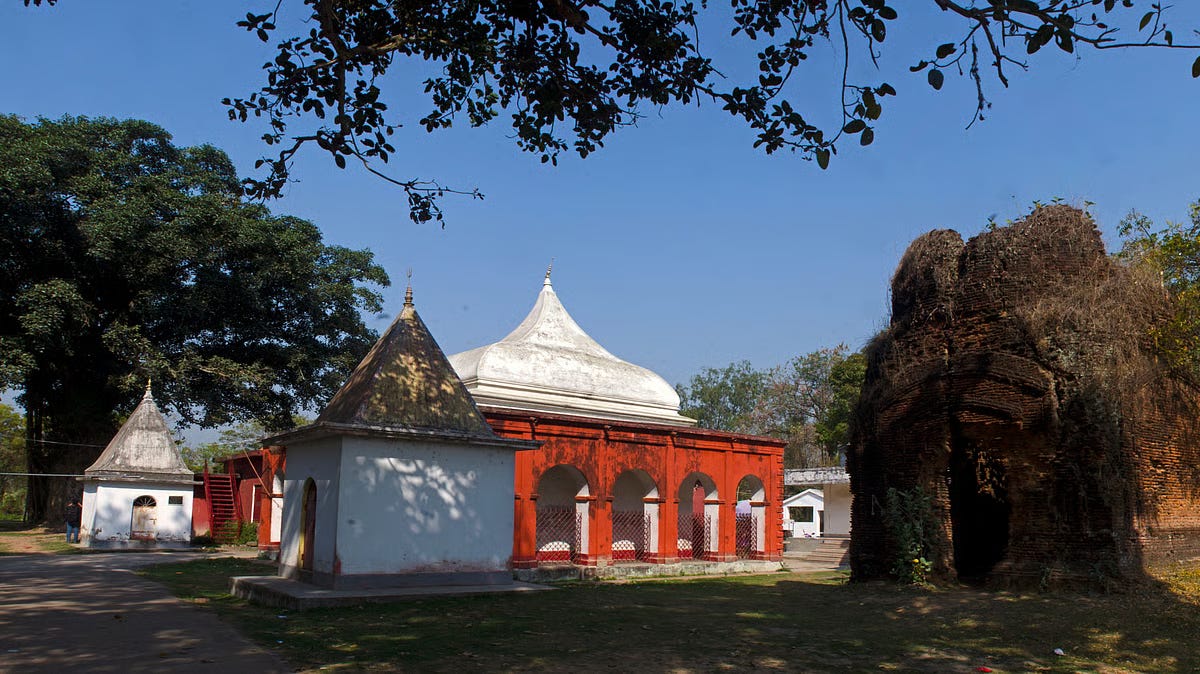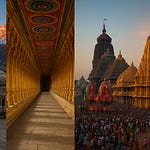In the rustic heartlands of Murshidabad, a region steeped in royal tales, Sufi whispers, and sacred hymns, lies the tranquil and revered village of Kiriteswari. Just 18 km from the historic city of Murshidabad, this modest hamlet in Kiritkona village has earned a national spotlight by being crowned the ‘Best Tourism Village of India 2023’ by the Ministry of Tourism, Government of India.
But beyond this accolade lies a timeless pilgrimage, a confluence of faith, culture, and community that tells the story of Bengal like few others.
Shaktipeetha Legacy: The Sacred Seat of Mukuteshwari
At the heart of Kiriteswari’s spiritual identity is its inclusion among the 51 Shaktipeethas -sacred sites scattered across the Indian subcontinent that are believed to mark the earthly locations where Goddess Sati's body parts fell after her self-immolation and the cosmic dance of Shiva.
Kiriteswari (Mukuteshwari) is believed to be the site where Sati's crown (Kirit) fell.
The presiding deity here is referred to as Mukuteshwari, meaning “Goddess of the Crown.”
Local reverence also identifies her as Mahishamardini, the slayer of the demon Mahishasura.
The temple holds immense Tantric and devotional importance and is visited by both Vaishnavite and Shakta pilgrims alike.
🏛️ Historical Echoes: A Timeline Through Time
🔹 Ancient Foundations
The origins of Kiriteswari temple are shrouded in antiquity. Oral traditions trace its existence to over 1,000 years ago, with mentions in regional manuscripts and tantric scriptures. It was one of the earliest and most revered spiritual centers in Bengal.
🔹 Destruction and Rebirth
The original temple is believed to have been destroyed in 1405 CE -likely due to natural disasters or political unrest during the turbulent decline of the Bengal Sultanate.
The current structure was rebuilt in the 19th century by Darpanarayan, the King of Lalgola, who re-established Kiriteswari as a spiritual capital of the region.
His royal patronage not only ensured the temple's restoration but also catalyzed the cultural flourishing of the surrounding areas.
🕌 A Temple of Harmony: Interfaith Participation and Syncretism
One of Kiriteswari’s most moving realities is its model of communal harmony. The temple committee includes Muslim villagers, who actively participate in temple upkeep, festivals, and rituals.
Land Donation by Muslim Residents: A significant gesture of unity, where land was donated to rebuild the Hindu temple destroyed centuries ago.
Shared Festivities: Many Islamic families participate in Hindu rituals and celebrations during the annual Paush Mela and Baisakh pilgrimages, upholding Bengal’s long history of syncretic faith traditions.
🌸 Rituals, Beliefs & Daily Worship
The temple's daily and annual rituals preserve the Shakta-Tantric traditions:
🕯️ Daily Rituals:
Mangala Aarti (early morning offering with lamps)
Pushpanjali (floral offerings)
Shakta Mantras are recited invoking the goddess’s protective powers.
Ghee lamps and incense fill the sanctum with divine fragrance.
🔔 Special Pujas:
Navaratri Celebrations (both Vasanta and Sharad Navaratri)
Jagaddhatri Puja and Kojagari Lakshmi Puja
Durga Ashtami Homam performed with 108 lotus flowers and shankha offerings.
🔄 Tantric Rituals:
The temple is associated with Dakshinachara (right-hand path of Tantra), though local sadhakas observe secretive rites during Amavasya (new moon) nights for spiritual empowerment.
🛕 Architectural Brilliance: A Bengal Temple Reimagined
🧱 Architectural Style
Kiriteswari Temple is an exceptional example of Bengal terracotta temple architecture:
Char-Chala Roof Design: Resembling four sloping roofs coming together at a central apex.
Ek-Bangla Veranda: A traditional Bengal hut-style porch adds intimacy to the temple entrance.
Curved Cornices: Echoing the influence of Mughal and Buddhist styles.
The black stone deity enshrined in the garbha griha is a powerful symbol of maternal energy and protection.
🧭 Academic Recognition
The temple's design has been documented and praised by David J. McCutchion, a renowned scholar on Bengal temple architecture, who highlighted its fusion of religious styles and folk traditions.
🎉 Festivals: The Heartbeat of Kiriteswari
🌾 Paush Mela (December–January)
A month-long fair held during the Bengali month of Poush.
Features a unique barter system where locals exchange paddy for handicrafts, oil, jaggery, mustard, and sweets.
Tribal and folk dances like Baha, Lagre, and Baul music enliven the village.
Spiritual recitals and night-long kirtans celebrate the goddess.
🌸 Baisakh Pilgrimage (April–May)
Coincides with the Bengali New Year (Poila Baisakh).
Special pujas, community feasts, and traditional Gajan festivals are held.
🏡 Sustainable Tourism and Village Revival
✔️ Eco-Friendly Growth
Kiriteswari’s recognition as India’s Best Tourism Village stems from its sustainable development approach:
19 homestays have been approved, run by local families, offering authentic experiences of Bengali village life.
The community promotes plastic-free zones, rainwater harvesting, and handicraft economy models.
🧶 Local Crafts
Visitors can buy:
Handwoven gamchas (towels)
Jute bags
Clay idols
Organic honey and mustard oil produced locally
🧭 Nearby Spiritual & Cultural Destinations
📍 Charbangla Temple
A rare quadruple Shiva temple complex with ornate terracotta motifs.
📍 Raj Rajeswari Temple
A graceful temple built in the rekha-deul style, dedicated to a fierce yet benevolent aspect of Durga.
📍 Bhaskar Pandit & Bhattabati Temples
Said to be built by renowned Tantric scholars and Pandits from Varanasi.
These temples are pilgrimage destinations during Mahashivratri.
📍 Jagatbandhu Dham
Revered by Vaishnavas, known for its connection with Jagatbandhu Sundar, a 19th-century Bengali saint.
📍 Jain Heritage Trail (Azimganj–Jiyaganj)
Over 30 exquisitely carved Jain temples, including:
Shri Neminathji Maharaj Temple (1887)
Chintamani Parshvanath Jain Temple
Fusion of Indo-Islamic, European colonial, and Jain aesthetics.
📍 Khosh Bagh – Garden of Happiness
Mausoleum of Siraj-ud-Daulah, last Nawab of Bengal.
Surrounded by mango trees, the site is both historically evocative and serenely beautiful.
🚗 How to Get There
By Air: Nearest airport is Netaji Subhas Chandra Bose International Airport, Kolkata (195 km).
By Rail: Murshidabad Railway Station connects to Howrah, Mumbai, Chennai, Ahmedabad, and more.
By Road: Taxis and auto-rickshaws available from Murshidabad.
By Ferry: Cross the Bhagirathi River via local boat services.
📆 Travel Tips & Best Time to Visit
October to March: Pleasant weather; ideal for spiritual retreats and village fairs.
Paush Mela (Dec-Jan): A must-attend event for cultural immersion.
Avoid peak summer (April–June) unless for religious purposes, due to high heat.
Why Kiriteswari Matters in Modern India
In an era defined by skyscrapers, concrete jungles, and digital disconnection, the village of Kiriteswari stands as a living testament to India’s deep spiritual consciousness and pluralistic ethos. While urban tourism often revolves around comfort and curated experiences, Kiriteswari offers something far more profound: a soulful continuity -a journey back to the sacred geography of India where myths breathe through rituals, where legends live in temples, and where communities still thrive on the values of coexistence and harmony.
🛡️ A Living Symbol of India's Pluralism
Kiriteswari is not merely a Shaktipeetha -it is a symbol of unity across faiths. In an age where religious polarization frequently makes headlines, Kiriteswari's inclusive temple committee, featuring Muslim members who actively participate in Hindu worship, provides a powerful model of communal solidarity rooted in mutual respect and shared heritage.
This seamless interfaith integration harks back to the ideals of Bhakti and Sufi movements that once flourished across Bengal, emphasizing love for the divine beyond divisions of caste or creed.
🧭 Rootedness in a Rootless World
As global citizens seek meaning in weekend getaways and digital retreats, places like Kiriteswari quietly remind us of the importance of rootedness. It invites travelers not just to observe—but to participate: in rituals passed down through generations, in fairs that revive ancient barter systems, and in architecture that carries the whispers of forgotten empires.
By walking through Kiriteswari, you don’t just see history -you feel time layered in prayer, in performance, and in soil.
🌱 Sustainability That Comes from Tradition
What modern sustainability planners preach today -local production, eco-consciousness, cultural preservation, zero waste -Kiriteswari has practiced for centuries. With its homestay-based tourism, minimal plastic zones, handcrafted economies, and community-led tourism, the village has become a beacon of rural sustainability without ever branding itself as such.
In Kiriteswari, progress doesn’t come at the cost of heritage -it is born from it.
🧘♂️ A Place for Reflection in an Age of Noise
Modern India is rapidly changing. The noise of politics, markets, and machines often drowns out the subtler voices of spirit, art, and ancestral wisdom. Kiriteswari is one such voice - gentle, persistent, and powerfully transformative. It is a place to pause, to recenter, and to reconnect with the eternal.
Whether you're a devotee seeking the grace of Mukuteshwari, a historian tracing the roots of Bengal, or a traveler longing for authenticity -Kiriteswari offers a mirror into what India was, what it is, and what it must protect to remain itself.
If your journey seeks more than destinations - if you seek stories, symbols, silence, and the sacred - then Kiriteswari awaits. From the goddess's crown to the songs of the soil, Kiriteswari is an invitation to rediscover India, one sacred footstep at a time.














